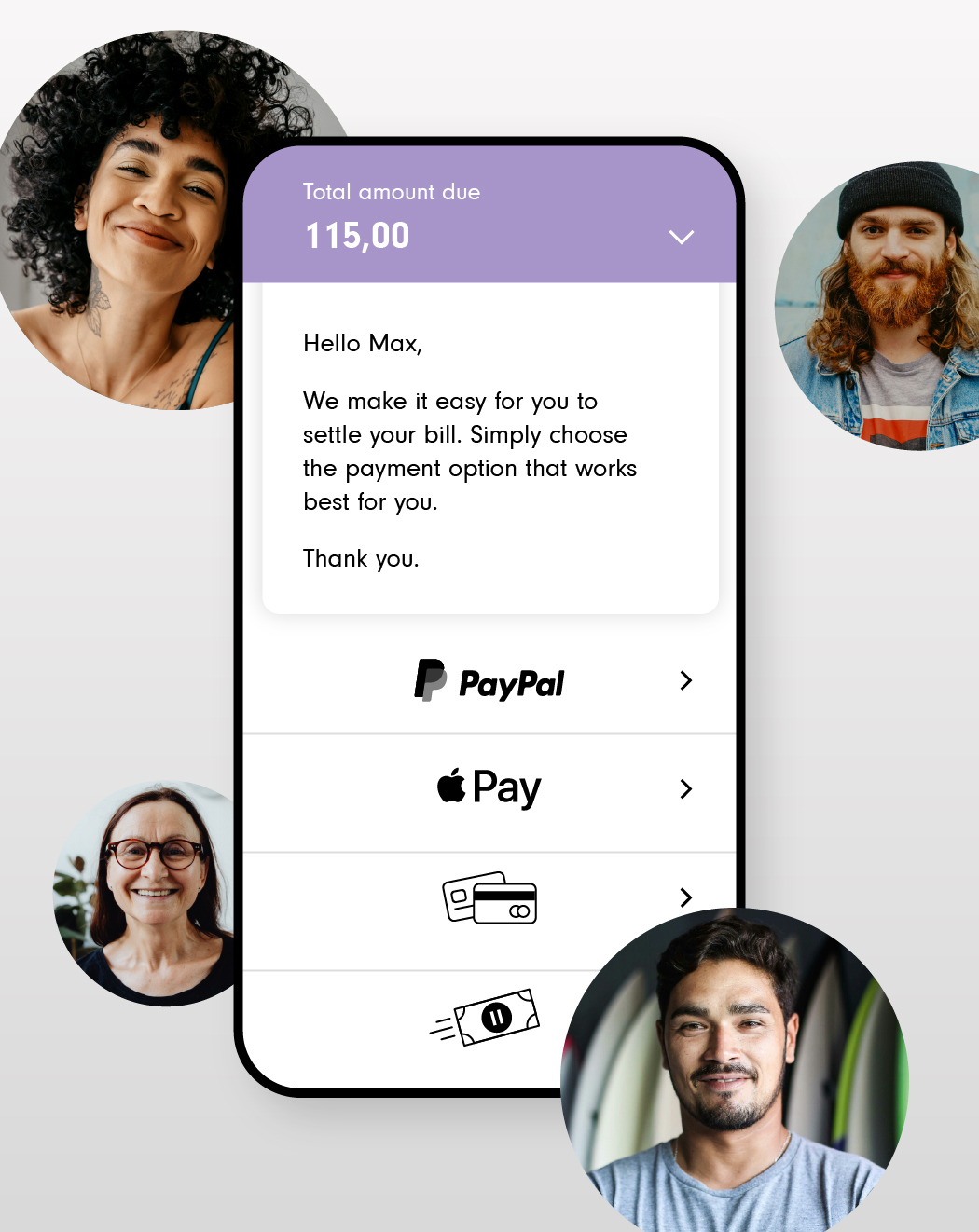Digital debt collection is the modern, technology-driven variant of classic receivables management. Instead of postal reminders, digital debt collection relies on AI-based automated processes and analyses, as well as digital communication channels such as email and digital messages.
The consumer is at the centre of the process and is given a personalised customer journey that makes repaying their outstanding debt as easy as possible. Data-based methods ensure that each consumer is addressed individually, maximising the repayment rate. The importance of modern digital debt collection is growing due to increasing payment defaults and ongoing digitalisation.
In this blog article, we explain how digital debt collection works at PAIR Finance, what trends we see and how it differs from traditional debt collection.
What tech innovations are behind digital debt collection?
Digital debt collection is based on a combination of advanced technologies that make the claims process more efficient and customer-friendly. Artificial intelligence (AI) plays a central role here: it analyses consumer response patterns, optimises the way they are addressed, for example, by choosing the best communication channel and the ideal time for each digital contact, or by helping to find a suitable payment solution. It is also used internally to efficiently manage consumer requests. The use of AI always aims to prevent further, sometimes very costly measures, for defaulting consumers and to keep the costs that the consumer may have to pay as a result of late payment as low as possible.
Various areas of AI are now making a decisive contribution to optimising basic debt collection tasks online and making them future-proof:
- Generative AI: This technology is used to recognise and categorise incoming requests. This pre-sorting then allows standard requests, such as instalment plan requests or payment holidays, to be answered automatically using pre-developed templates. Voice-controlled systems (VoiceAI) can also be integrated to make interaction more intuitive. Generative AI serves as a tool to accelerate processes (Find out more in our blog post on generative AI in debt collection).
- Reinforcement learning (RL): a learning style in the field of machine learning that enables a personalised customer approach by taking into account individual aspects and reaction patterns. Q Learning is a complex form of RL, to predict the optimal approach in the long term. This can be used, for example, to determine the best time or the most effective communication channel for a payment message.
- Supervised learning: Supervised learning is used to predict specific events and their probabilities. Algorithms are trained with labelled data sets to recognise patterns. In receivables management, this can help to better assess the probability of a consumer making a payment and determine the next possible action.
How does the digital debt collection process work?
- Data analysis and typology: First, existing customer data is analysed to create an individual communication plan for consumers. This is based on a variety of individual factors such as the amount of the claim, environmental information or previous reactions. The aim is to get a picture of the consumer as accurately as possible and to contact them in the most appropriate way. (Find out more about typology in our customer typology study).
- Automated approach: Based on their typology, consumers are contacted via the optimal communication channel, such as email or other digital messages. AI-based systems determine not only the right channel, but also the appropriate tone, the best time and the ideal wording of the message to ensure a quick response. This significantly increases the likelihood of successful communication and payment.
- Digital payment processing: Consumers receive a personalised payment link with popular payment options such as PayPal, Klarna, credit card, direct debit, instalment payments or even cash payments in partner stores (find out more about our integrated bank transfer here). This simplifies and speeds up the payment process. If desired and eligible, consumers can arrange an individual instalment payment directly on the payment page to settle the outstanding debt at their own pace.
- Continuous optimisation: AI is used throughout the communication process and adjusts the strategy based on consumer responses. If an initial message goes unanswered, alternative communication methods or a modified approach are used. The aim is to find a quick and customer-friendly solution that is beneficial for both consumers and our business customers.
What are the advantages of digital debt collection?
- Faster response times: 90% of consumers with outstanding debts are successfully reached within 90 days.
- Higher success rate: personalised approach and simple digital payment methods lead to higher payment rates.
- Cost efficiency: Automated processes reduce manual processing time and lower costs for business clients.
- Customer satisfaction: 84% of consumers are satisfied after the debt collection process.
- Client portal: Provides predictive analytics and real-time case status.
- Paperless processing: Minimises environmental footprint.
- Self-determined settlement of the outstanding claim: No confrontational phone calls, with personal solutions always guaranteed when actively contacting the customer.
- Availability 24/7: Flexible solutions around the clock.
- Strong pre-court debt collection management: Saves costs for companies and, as a result, for consumers who are liable for reimbursement.
How does digital debt collection differ from traditional debt collection?
|
Feature |
Traditional debt collection |
Online debt collection |
|
Communication channels |
Letter, telephone |
E-mail, SMS, WhatsApp if necessary |
|
Speed |
Several days/weeks |
Immediate contact possible |
|
Use of technology |
Standardised, mainly manual processing |
Automated, but individualised processing through the use of AI, supplemented by manual processing only where necessary |
|
Payment options |
Transfer, direct debit |
Online payment links with many different customisable options |
|
Personalisation |
Standardised reminders |
Individual approach based on data analysis |
|
Claim transfer |
Manual process/file transfer |
Automated API |
What is the legal framework for digital debt collection?
Digital debt collection is subject to strict legal regulations, particularly in the area of data protection. All measures must be GDPR-compliant in the EU/EEA or comply with the respective national requirements (such as the DSG in Switzerland) so that consumers’ personal data is only processed to the extent necessary. In addition, there is a transparency obligation: consumers must be informed clearly and comprehensibly at all times about their outstanding debts and the available payment options.
Furthermore, in some countries, debt collection companies may only recover debts if they are registered with the relevant national authority, and the measures taken must be fair and proportionate, often in line with industry standards of conduct. This also means that no disproportionate costs may be charged and no undue pressure may be applied.
In addition to compliance with data protection requirements, we also prioritise the protection of sensitive customer data as evidenced by our ISO 27001 certification, which demonstrates that we have a certified management system for information security.
Can digital debt collection also be used internationally?
Digital debt collection has the advantage that it can also be used across national borders, but subject to the relevant country-specific legal requirements. Cultural and language differences and local payment methods also play an important role in international debt collection.
The PAIR Finance ONE Approach is a good example of this. This model allows companies to scale their debt collection processes internationally by providing a standardised digital platform which takes account of country-specific factors and allows the status of the files transferred to be monitored 24/7 in real time.
AI-supported communication in the respective national language and adapted payment methods for each market ensure that consumers can be reached efficiently internationally. This strategy simplifies cross-border debt collection and increases the success rate.
Conclusion: The debt collection solution for the digital age
Digital debt collection offers companies a fast, efficient and customer-friendly solution for receivables management. By using AI and digital communication channels, the collection process is optimised, making it easier to reach consumers and collect payments faster.
—————————————————–————————
Want to find out more about PAIR Finance, digital debt collection or working with us? Contact us now.



